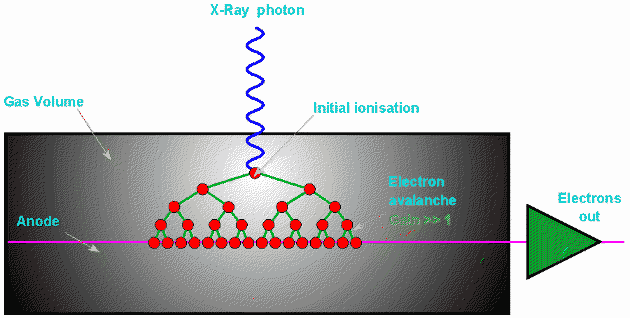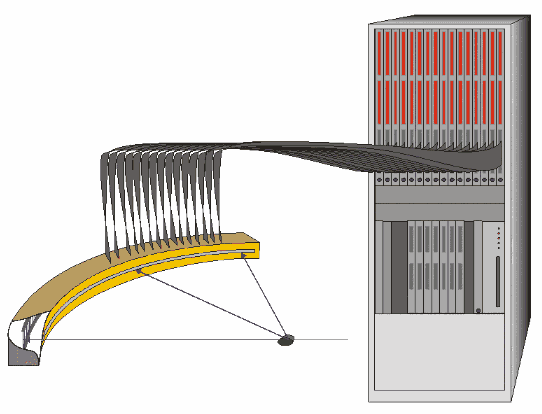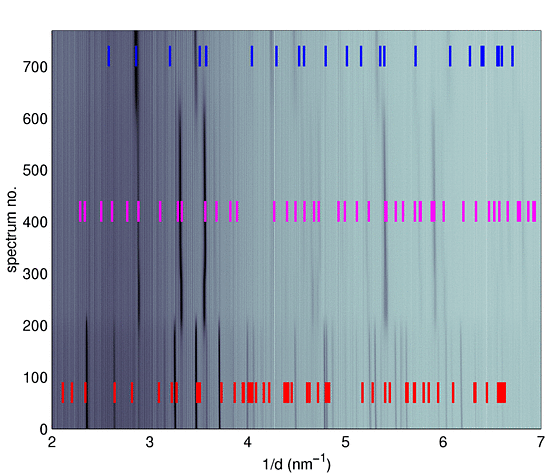 |
Detectors
I. Point & Line Detectors |
 |
Detectors
I. Point & Line Detectors |
Point & Line Detectors
Point scintillator counters
This detector type has a long history. Photons entering a doped crystal lattice (e.g. sodium iodide) create electron trap centres which decay to give usually a fair number (e.g. 200) of optical photons which can be detected by almost any optical device (photo-multiplier tube; human eye). The detector is effectively a single point detector so in order to detect photons at different positions an array of scintillators would have to be constructed, at some cost. The main advantages are its long history, cheapness (as a point detector), high dynamic range (e.g. 106 to 107) and that it does have some energy discrimination (typically 30%). They are obviously indirect and photon counting.
Gas detectors
These are direct, photon counting devices which exploit the gas amplification effect; that is X-rays entering an inert gas will eject electrons from the gas atoms, and these electrons will have enough energy to kick out yet other atoms' electrons in a cascade (typically 200 electrons per incoming photon). An electrical voltage across the gas separates the electrons and ions with the electrons usually made to drift towards a positively charged (anode) wire, producing yet more electrons (the "avalanche" effect) in the process. Thus a large number of electrons are produced from one incoming photon; typically, 1 photon → cascade of 200 electrons → avalanche of 2 million electrons. This process is illustrated below:

The final electric signal is ideal for further amplification and electronic processing, realising very high (e.g. 108) dynamic ranges; they normally operate at count rates of 104 cps (though "specials" can go much higher such as RAPID1 and RAPID2) and have a useful energy discrimination of ≈15%. These detectors too have a long history of development and are relatively cheap when used in point counting mode. However an important variant with gas detectors is that they can be converted from point counting to position sensitive detectors (psd's), but at some cost. The way this is done involves measuring the induced charge dissipation down the resistive wire in each direction (or the equivalent determination using an induced signal - delay line system) from which the location of the original avalanche can be determined. Such methods are limited by multi-coincidence (i.e. when more than one photon-electron avalanche hits the wire at the same time) limiting the usable maximum count rates to 103 to 104 cps for commercial systems. However more recent developments have been geared towards ganging up a large array (e.g. 128, 256 or 512) of such wires within one gas box together with multi-electronic processors. Prototype versions of these multi-wire detectors (called RAPID1 and RAPID2) designed to deliver global countrates of up to 20 MHz have been built at CLRC Daresbury Laboratory. The following two figures give, respectively, a schematic of its operation and a photograph of it installed on the powder diffractometer of station 6.2 of the Daresbury SRS:


Although this detector still awaits full calibration, its collection performance has been demonstrated with various heating experiments such as the gypsum → bassanite → anhydrite transformations. This is shown in the following figure; the three phases are clearly seen with overlaid sticks corresponding to standard reference patterns. The 750 patterns each had a 3 second acquisition time; the wavelength was 1.0 Å and the data span 100°C to 600°C.

Solid State (semiconductor)/Energy-Dispersive detectors
These are primarily direct, photon counting detectors though they can also be used in the integrating mode. They exploit the creation by photons of electron-hole pairs in semiconductor crystals (conventionally silicon or germanium). For example a 10 keV photon will create around 2600 electrons (3.8 eV being the energy to create a typical electron-hole pair) and while this is not the millions obtained with gas detectors, it is still very detectable and of course being a semiconductor it will connect directly to a pre-amplifier system. Because each photon produces an electrical pulse which is proportional to the energy of the incoming photon, the energy of the photon can be determined as a bonus so the energy discrimination is excellent (typically 2-3%); the dynamic range is also good (≈104). The chief drawbacks are (1) the maximum count rate is limited in practice to around 104−105 cps, and (2) that, although excellent, the energy discrimination is annoyingly just that little bit too poor for energy-dispersive diffraction methods to compete with the resolution of angle-scanning diffraction. It might also be added that such systems have been around commercially for about 30 years and the cost could now be described as intermediate in spite of the cryogenic cooling required for the semiconductor crystal and pre-amplifier.
|
© Copyright 1997-2006.
Birkbeck College, University of London.
|
Author(s):
Paul Barnes Martin Vickers Rob Lewis |